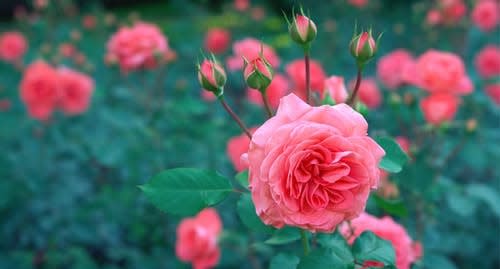Gardening: Roses are known for their beauty and fragrance, but can be difficult to grow

The rose is one of the oldest flowers in cultivation and is still considered one of the most popular garden flowers today. The flower is so popular that in 1986, Congress named the rose our national floral emblem. Most modern roses are descendants of eight European and Asian rose species. The elaborate flower forms and colors of many rose cultivars available today are the result of extensive breeding and hybridizing that began in the 1800s.
Many gardeners are wary of growing roses because they tend to have the reputation of being difficult to grow. Many roses are also susceptible to disease and insect problems, requiring a regular pest control program in order to flower and remain healthy. This can be especially true for hybrid tea varieties and floribundas and grandiflora types of roses. But if the beauty and fragrance of roses are irresistible to you as a gardener, here are 10 tips to successfully cultivate roses.
Gardening: Maximize the size of your tomatoes by following these helpful pointers
1. Choose disease-resistant varieties, as diseases such as black spot and botrytis are usually responsible for the demise of roses. While resistance does not mean that roses cannot still be susceptible to diseases, it greatly reduces the incidence of diseases, particularly foliar diseases.

2. Locate roses in a full-sun location that receives a minimum of 6 hours of sun each day. Morning sun is the most desirable for roses; it helps to dry off rose foliage quickly, reducing the potential for the development of foliar disease organisms.
3. Plant roses in well-drained fertile soil, as roses require good drainage. Roses can flourish in high-clay soils as long as it is well-drained. When planting roses into soils low in organic matter, be sure to amend the soil with compost, peat moss, or some other type of organic matter.
4. Space roses at least 3 feet apart to provide adequate room for the plants to grow and space for good air circulation, which will also reduce the development of fungal diseases. Don’t plant roses close to trees, shrubs or lawn areas, as the roots of roses do not compete well with roots of these plants.

5. Apply a layer of organic mulch on the soil around rose plants. A 3-inch layer of organic mulch will suppress weeds, conserve soil moisture, and moderate soil temperatures. This is especially important since roses have very shallow root systems.
Gardening: Coexisting with critters takes ingenuity to make plant buffet less appetizing
6. Keep soil moist during periods of dry weather. Roses require a fair amount of soil moisture. Avoid the use of overhead sprinklers, as wet foliage favors the development of foliar disease organisms. Water the soil, not the foliage, and water deeply once a week rather than repeated shallow waterings. Water early in the morning so that the foliage has a chance to dry out during the day.
7. Fertilize roses frequently to encourage vigorous growth and abundant blooms. Apply organic fertilizers such as compost or cottonseed meal or an all-purpose fertilizer such as 10-10-10 three times during the growing season. Do not apply fertilizer to roses after the beginning of August in order to discourage late season growth, which can be more susceptible to winter damage.

8. Constantly monitor roses for evidence of pests. Insects like Japanese beetles and rose slugs can quickly damage the foliage of roses. Be prepared to use chemical controls like pesticides and cultural controls such as hand-picking pests from plants.
9. Deadhead spent flowers to encourage new blooms. Some varieties of landscape roses such as Knockout roses do not require deadheading for continued blooms. To promote hardening of roses for winter, cease deadheading in late summer.
Gardening: Want a tropical appeal in your landscape? Consider cannas for a splash of color
10. Provide winter protection for roses. Cold temperatures and drying winds can cause rose canes to dry out and die. After the first frost in the fall, remove any leaves, broken branches, or debris from around the base of the plant and mound up some light garden soil, mulch, or straw around the base of the plant to a depth of about 12 inches. Be sure to remove this material in the spring after the threat of freezing temperatures has ended.
Follow these few tips and you will enjoy the beauty, color, fragrance and elegance of roses.
This article originally appeared on The Columbus Dispatch: Roses: Follow these 10 tips to successfully grow healthy flowers

